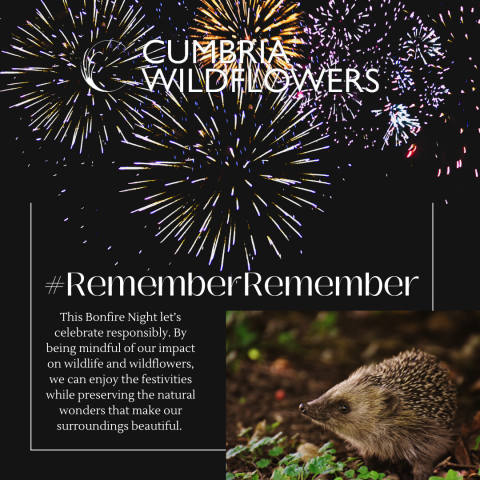Bonfire Night: Celebrating Safely for Wildlife and Wildflowers
Bonfire Night, a beloved tradition, lights up the autumn sky with dazzling displays of fireworks and roaring bonfires. However, amidst the festivities, it's essential to consider the impact on our wildlife and wildflowers. At Cumbria Wildflowers, we're passionate about preserving our natural habitats. Here are some insights into how Bonfire Night can affect wildlife and ways we can celebrate responsibly.
**1. ** Firework Fright:
Fireworks can cause some indirect impacts to our native wildlife. The loud noises and bright lights can disrupt their natural behaviour, leading to disorientation and disturbance. Birds, hedgehogs, and bats are particularly sensitive to these disturbances.
Mitigation Tip: Opt for silent or low-noise fireworks to minimise stress on animals if you are in a highly sensitive wildlife area. Also keep fireworks from roosting areas of bats and birds.
**2. ** Bonfires and Wildlife Refuge:
Bonfires, often made of piled leaves and twigs, can become hiding spots for various creatures like hedgehogs, frogs, and insects. Lighting the bonfire without checking can lead to serious harm.
Mitigation Tip: Before lighting, thoroughly inspect the bonfire for any signs of wildlife. Create a small barrier around it to discourage animals from seeking refuge inside.
**3. ** Protecting Wildflowers:
Some bonfire locations may be in areas of fields/habitats that could create damage to native plants, meadows, verges or woodland. The bonfire location once burnt will cause a dead area of ash and debris.
Mitigation Tip: Encourage celebration in designated areas, leaving natural spaces and sensitive habitats undisturbed. Educate attendees about the importance of wildflowers and the role they play in supporting local ecosystems.
**4. ** Light Pollution:
The bright lights from fireworks and bonfires can create a temporary impact to nocturnal animals, especially bats with the lights affecting their hunting and navigation abilities.
Mitigation Tip: Where possible use minimal external lighting during festivities and keep the firework display to a sensible length of time.
**5. ** Litter and Pollution:
Post-celebration, littering becomes a significant issue. Plastic wrappers, spent fireworks, and other debris can pose threats to wildlife, pollute water sources and be very unsightly.
Mitigation Tip: Organise clean-up crews to ensure all waste is properly disposed of. Encourage the use of biodegradable materials in fireworks and discourage the release of sky lanterns, which can harm animals and start fires. If sky lanterns to be used best to use fully biodegradable varieties.
This Bonfire Night let's celebrate responsibly. If we are mindful of our impact on wildlife and wildflowers, we can enjoy the festivities while preserving the natural wonders that make our surroundings beautiful. Together, we can make Bonfire Night a joyous occasion for everyone, humans, and nature alike.
When you subscribe to the blog, we will send you an e-mail when there are new updates on the site so you wouldn't miss them.



Comments